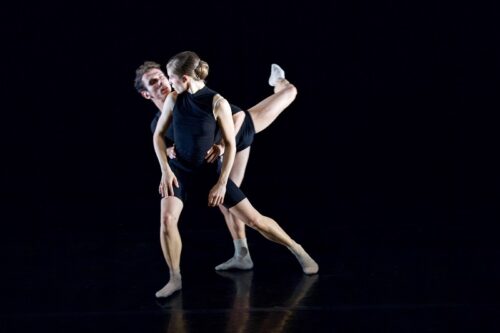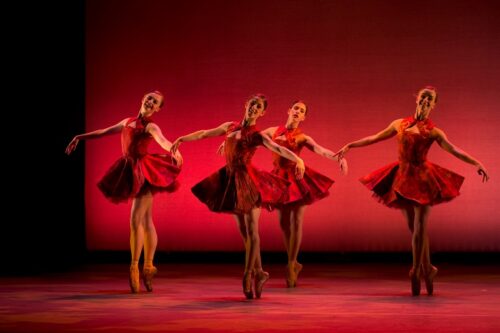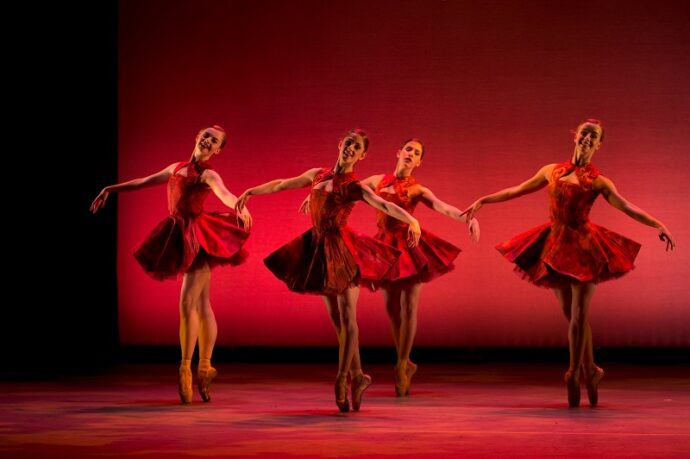 United Kingdom Next Generation Festival: NEBT – Into the Spotlight: Dancers of New English Ballet Theatre. Linbury Theatre, Royal Opera House, London, 17.6.2022. (JO’D)
United Kingdom Next Generation Festival: NEBT – Into the Spotlight: Dancers of New English Ballet Theatre. Linbury Theatre, Royal Opera House, London, 17.6.2022. (JO’D)

Domino
Choreography – Ruth Brill
Music – Ryuichi Sakamoto
Dancers – Jill D’Haene, Natalia Kerner, Demelza Lesage, Mischa Goodman, Tim Morgenstern, Xholindi Muçi
Nocturne
Choreography – Daniela Cardim
Music – Chopin, Nocturne No.13 in C minor Op.48 No.1
Dancers – Camino Llonch and Daniel Corthorn
Rosamunde
Choreography – Morgann Runacre-Temple
Music – Schubert’s Rosamunde string quartet, arranged by Tom Lane
Dancers – Giorgia Capogna, Natalie Kerner, Camino Llonch, Eric Caterer Cave, Daniel Corthorn, Mischa Goodman, Xholindi Muçi
Solace
Choreography – Georgie Rose
Music – I Am Sorry Not Sorry by Kate Armine and Ruby Fulton; Pale Blue Dot by Roger Goula
Dancers – Olivia Boyd, Jill D’Haene, Giorgia Capogna, Natalia Kerner, Mayuko Suzuki, Eric Caterer Cave, Daniel Corthorn, Mischa Goodman, Aitor Viscarolasaga López
I Can’t Dance
Choreography – Kristen McNally
Music – Genesis
Dancers – Olivia Boyd, Giorgia Capogna, Jill D’Haene, Genevieve Heron, Camino Llonch de Prado, Mayuko Suzuki, Kevin Alsina, Orlando Bond, James Garrington, Patrick Gill, Xholindi Muçi
The Four Seasons
Choreography – Jenna Lee
Music – Vivaldi, The Four Seasons (recomposed by Max Richter)
Dancers – Mayuko Suzuki and Xholindi Muçi, Demelza Lesage, Camino Llonch, Natalia Kerner, Eric Caterer Cave, Mischa Goodman, Tim Morgenstern, Aitor Viscarolasaga López, Olivia Boyd, Jill D’Haene
In the words of founder and Artistic Director, Karen Pilkington-Miksa, New English Ballet Theatre ‘provides young dancers with the professional experience they need for a chance to be accepted into a major professional company’. As part of the Next Generation Festival at the Royal Opera House, the company’s Into the Spotlight programme presents work by six contemporary women choreographers. Its bright-eyed dancers demonstrate their nascent talents across a range of dance styles and endear themselves to the audience along the way.
After choreographing more complex work for Birmingham Royal Ballet a few years ago, Ruth Brill opts here for simplicity and precision. Domino shows six dancers in dotted tabards of red, white and black tracing patterns on the stage rather as the dancers of Frederick Ashton’s Symphonic Variations. ‘Very nice’, a man in the row behind me said when this opening piece had come to its logical and satisfying conclusion.
Daniela Cardim’s Nocturne, by contrast, is an intense pas de deux in dark blue silk to the music of Chopin. Strong, well-matched, expressive, its two dancers work through their emotional crisis like the couples in Jerome Robbins’s In the Night, incorporating jetées, chainé turns and the dragging along the floor of the woman by the man that characterises the pas de deux of Kenneth MacMillan.
In Rosamunde, Morgann Runacre-Temple introduces the ‘alien aesthetic’ of Wayne McGregor (a choreographer with whom she has worked). It is there in the movement of heads, necks and shoulders and in the frequent deep pliés as black-clad dancers explore, in a close-knit group, the theme of hands touching bodies. Schubert’s Rosamunde Quartet is given an alien aesthetic of its own in a modern arrangement by Tom Lane.
Georgie Rose’s Solace is the one work on the programme for which the name of a male choreographer does not present itself as a reference. There are no leotards or tights. The dancers wear baggy suits of dull yellow, and polo neck sweaters of what could be lime green. To Ruby Fulton’s repetitive I Am Sorry Not Sorry they repeatedly support each other or let each other fall. Just when you are beginning to wonder if it isn’t all rather cramped, and over-costumed, and underlit, the women enter the stage as a group in a backwards bourrée. From that moment the piece opens out and takes flight as it moves towards a climactic coup de théâtre, involving one man and his suit, that makes you want to see the whole thing again.
Hofesh Shechter would be the reference for Kristen McNally’s I Can’t Dance, presented here in a four-minute-long film by Alice Pennefather. The huddled group of dancers; the bowed shoulders: they bring to mind Shechter’s Untouchable, his work for The Royal Ballet in which Kristen McNally performed. Despite the humour in its title, the filmmaker’s skill and Nina Kobiashvili’s elaborate costumes, as a piece of filmed dance it seems out of place on this programme of live performance.

Jenna Lee’s The Four Seasons, to Max Richter’s ‘recomposition’ of Vivaldi, is an NEBT perennial. It changes according to that year’s cohort. At twenty-two minutes, it is the longest work on the programme. It tests the staying power of the performers, even as they dance only Summer and Winter. For Summer, they wear leotards and tight-fitting shorts. For winter, intricate but also diaphanous costumes redolent, like the neoclassical choreography, of a ballet by Balanchine.
As bright-eyed at the end of the six-work programme as they were at the start, the dancers take their curtain calls. The audience, charmed, is left to wonder into which spotlights they might be headed.
John O’Dwyer
